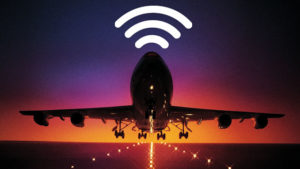Huangpu District (Guangzhou Development District) Government of Guangzhou City and BlueFocus IFEC Technology Co., Ltd officially announced in Guangzhou on 9th October that a ‘The Belt and Road’ Inflight Internet Fund with a capital injection of ten billion yuan will be established, together with China’s first Inflight Internet Centre for Mass Entrepreneurship and Innovation, and a trillion-yuan Inflight Internet Industrial Park. This shows that the ambitious inflight internet plan has been included on the Chinese government’s agenda. With this Plan to be implemented, China is poised to become another major competitor in inflight internet industry, together with the United States.
At present, with the closing of the 19th CPC National Congress, the main contradiction of Chinese society has been transformed into a contradiction between people’s growing needs for a better life and unbalanced and inadequate development of society. Based on this philosophy, the Chinese government is determined to work hard to benefit 500 million passengers with non-stop online surfing experience on their inflight journeys within the next five years.
Chinese society has undergone enormous changes since its Reform and Opening-up roughly 40 years ago. The change is particularly conspicuous in the internet industry, as is seen in its 751 million internet users – 1/5 of the world’s total. Chinese internet penetration rate has reached 54.3%, a 4.6 percentage points higher than the global average. China has 700 million mobile Internet users with an annual growth rate of 5.9%, and an overwhelming 95.1% of its internet users are on their mobile devices. Global finance and technology has entered the China-US double-wheel driven era called ‘G2’, which has seen a spate of outstanding internet firms such as Baidu, Alibaba and Tencent (commonly referred to as ‘BAT’). Unlike the popularity of the internet, the development of China’s inflight internet began relatively late, thus somewhat lagging behind the United States. The Chinese government recognizes this situation and has started to actively put into practice this newly-formed Plan.
There are currently about 55 airlines around the world that provide inflight internet services. Of the 4000+ Wi-Fi-equipped aircrafts, more than 80% are now serving in North American airlines. As of 2016, more than 78% of flights provide cabin Wi-Fi service in the United States, followed by Europe and the Middle East, with Asian airlines still falling behind. The United Airlines fleet has a Wi-Fi penetration rate of 100%, followed by Delta Air Lines (95%), Emirates (87%), JAL (77%) and Lufthansa (70%). According to the research finding of OnAir, a Swiss research company, 75% of airlines plan to invest in inflight Wi-Fi services for their passengers, and 70% of the airlines are now investing in inflight internet service training for their employees. Since the first Air China aircraft with inflight Wi-Fi made her maiden journey, China now has only 140 Wi-Fi-enabled aircrafts in operation, representing only 6% of the total size of China’s civil aviation fleet, which means each year nearly 500 million passengers are not connected to the most basic internet services during their flight. The Chinese government has taken note of this strong demand and realized that when the core technology is withheld by the Western countries, its information and data are exposed to substantial security risks.
The focus of the Chinese government’s ambitious initiative lies in the satellite layout. From 2016, Guangdong Provincial Government has begun strategic planning in the upstream of the inflight internet industry chain. On 23rd July 2016, Shenzhen Municipal Government started the construction of China’s first global high-throughput broadband satellite communications system, who plans to launch the first high-throughput broadband satellite by the end of 2018 and starts satellite communications operations services in 2019. In April 2017, China’s first high-throughput communications satellite ‘Zhongxing-16’ was successfully launched, with a total communication capacity of more than 20G. This signifies that broadband applications of independent communications satellite has been realized through China’s independent research and development technology and China has broken loose from foreign monopoly.
At the operational level, as the core area of China’s scientific and technological innovation hub, Huangpu District (Guangzhou Development District) is endlessly seeking new development momentum in its efforts to play a leading role in the sector through the accumulation and radiation of innovative resources. Driven by the Belt and Road Initiative (B&R), Huangpu District (Guangzhou Development District) has established the ‘The Belt and Road’ Inflight Internet Fund, China’s first Inflight Internet Centre for Mass Entrepreneurship and Innovation, and an Inflight Internet Industrial Park in a bid to promote Chinese products and content with independent intellectual property rights to the airlines along the B&R countries, while supporting an array of outstanding enterprises with independent intellectual property rights.
With the deepening of China’s all-round diplomacy, great power diplomacy with Chinese characteristics has borne the features of being comprehensive, multi-level and three-dimensional, creating a favorable external environment for China’s development and the implementation of the B&R Initiative. Civil Aviation Administration of China (CAAC) has signed bilateral air transport agreements with more than 60 countries along the B&R, among which more than 40 countries agreed on direct flights, shuttling a total of around 4200 flights per week. China’s domestic airlines such as Air China, China Southern Airlines, China Eastern Airlines and Hainan Airlines have all increased aviation capacity in nations along the B&R, with over 200 new air routes being newly launched. In 2017, international routes along the B&R remains the focus for many airlines. Since 29th October 2017, China’s domestic airlines plan to launch 95 new international routes along the B&R, mainly in Eastern Europe, Central Asia, Southeast Asia, South Asia and the South Pacific countries. Meanwhile, foreign airlines are set to launch 18 new international routes along the B&R, principally in the Philippines, Malaysia, Thailand, Vietnam, Cambodia, Kazakhstan and other countries.
According to the Plan, Huangpu District (Guangzhou Development District) will provide support in policy, land, capital and other areas. BlueFocus IFEC will bring together leading companies as stakeholders in the whole industry chain to maximize industrial value through commercial operation, as well as to foster a hundred-billion-yuan industrial cluster in five years. Despite the fact that there evidently are difficulties and challenges due to temporal and technical barriers, this ambitious plan can be seen as an important booster and driver for the current development of China’s inflight internet.
Currently reading:
201









Leave a Comment